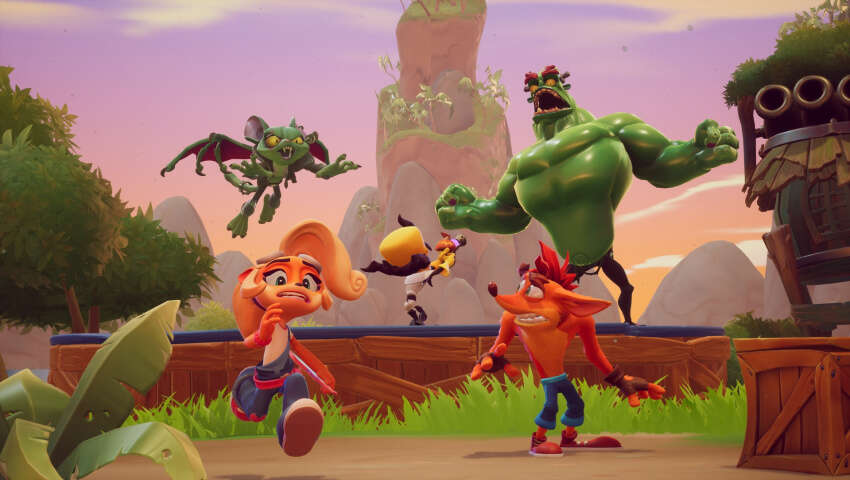There are few games that serve as better examples of the industry’s changing landscape than Crash Team Rumble (CTR). Once a single-player mascot platformer at the height of the genre’s popularity, CTR takes the heroes and villains of Naughty Dog’s, and later Activision’s, series and reimagines it as a 4v4 multiplayer game with live-service elements. To some, that might sound like a myopic deathblow to a once-proud series. On the contrary, Crash Team Rumble is a fun and surprisingly tactical PvP game, albeit sometimes held back by oft-seen growing pains of games-as-a-service.
In Crash Team Rumble, two teams of four square off in platforming arenas that, at first glance, each look a bit like wide levels from a typical Crash game. Enjoyably, the controls and feel of the game perfectly capture those of traditional Crash games, too, making it an instantly recognizable experience in one’s hands.
Though the game has just one mode at launch, it’s designed very well. The goal is to score 2,000 wumpa fruit before the rival team does. To do this, players will spin over, slam onto, and slide into crates and loose wumpas all around the arena to collect them. Moving them to a goal area will, after a moment, score them for the team permanently. But the exciting chaos of CTR exists in this in-between space, and often even on the goals themselves.

Each team can be composed of whichever characters they see fit, which reliably results in rounds playing out differently each time. Eight characters split across three classes are available at launch: scorer, booster, and blocker. Scorers are usually faster and can carry more wumpas, thus scoring more at a time. Blockers are very enjoyable defenders, with denial-of-area or higher damage-inflicting moves meant to constantly disrupt enemy scorers like a fly forever buzzing around their ears. Boosters are sort of the in-betweeners, meant to focus on activating multipliers and unlocking map-specific abilities, like Aku Aku masks that give the whole team a health and movement buff similar to what past Crash games had.
Thresholds for unlocking these game-changing abilities are high, but work well as a result. It takes a concerted team effort to obtain them, which means a team will always have to balance chasing those powerful unlocks with scoring or playing defense. All eight players in the arena will have multiple things to focus on at all times, creating a high skill ceiling for those who use their time and space wisely.
Each character can be further enhanced with unique skill unlocks that aren’t limited to certain classes. You can further enhance Crash’s scoring abilities with the Wumpa Stash, giving yourself 100 or more additional wumpas over time, or you could bolster his defensive abilities by dropping a Gasmoxian Guard on the enemy’s goal, thereby routinely zapping them and interrupting their scoring attempts, with the added bonus being that taking damage results in dropped wumpas. Characters having both innate and customizable abilities like these allow for further variance from round to round, as even a group of eight identical skins may across two rounds may belie a change in strategy that comes from a change in assigned cooldown skills.
In my time with the game, it was easy to take the reins of a new character or ability and quickly figure them out. I definitely have favorites today in both respects, but each character’s and skill’s use-case is apparent, and it’s really satisfying to get to grips with each of them.
A team could roll out with four people playing as Crash, a scorer, but they’d be hard-pressed to prevent the enemy team from scoring, too. Alternatively, a team could bulk up on defenders like N. Tropy and Dingodile, but they’d be at risk of scoring too slowly. The game allows players to create their own team comps, which definitely can result in some lopsided matches. However, in my experience, some seemingly deficient team comps still led to victory when the team played cohesively. Voice comms feel more necessary in Crash than in many other PvP games, and as a result of that, I took to mostly playing with my squad of four, enjoying it less when jumping in with random players.
All eight players in the arena will have multiple things to focus on at all times, creating a high skill ceiling for those who use their time and space wisely.
Crash Team Rumble offers a surprising level of depth despite having just the one game mode right now. It very much feels like a quasi-sports game, akin to Rocket League or Fall Guys, just as much as it still retains the classic feel of a Crash game. I find this to be its greatest attribute–creating something new that still feels immediately familiar and easy to understand.
While strategies change from round to round, the game is consistently frenzied. Each player has goals and intentions, but they can change on a dime. I would often laugh when blockers got tunnel vision for me, thereby chasing me down fruitlessly (no pun intended) as my mobility options were greater than theirs, and this chase sequence allowed my allies to take advantage in other ways, like activating multipliers or scoring their own wumpas.
In other rounds, my brother and I would align as dual N. Brio blockers, each with Gosmoxian Guards equipped. These area-of-effect behemoths, paired with Brio’s innate skill to morph into a hulking brute and clear out a goal like a nightclub bouncer, resulted in a laugh-out-loud defensive strategy for us that won us many consecutive matches until we finally came upon a team that effectively countered us. It feels like there are a few reliable meta strategies in the game’s early days, but nothing is foolproof that I’ve seen, and that is really exciting as someone living in a post-Knockout City world, looking for the next fun arcade “sports” game.
Because team strategies can change so much in the middle of each 5-10-minute round, I witnessed some major scoring deficits be erased. A team down by over a thousand wumpas, for example, can still make a comeback if they decide to clamp down on defense, throwing all manner of blocking attacks and abilities at the enemy’s goal while perhaps a single scorer accumulates wumpa slowly but surely. CTR would be dead on arrival if an early lead meant the game were already over, but that’s not the case at all, provided a team knows what it’s doing.
All the while, an esports caster-like announcer calls a round, adding a bit of extra excitement. He doesn’t say much, but when he chimes in to announce how a round is coming down to the wire or an enemy team has just called in a map’s major unlock, like a UFO that chases down players relentlessly, it definitely adds to the drama. The potential for late-stage heroics and comebacks, however, does make it annoying that players can’t swap characters mid-match. Whoever a player starts a round with is who they’ll finish the game with, which seems like an oversight.

In general, the game gets its competitive elements right, while a lot of its more troubled aspects exist in the menus and the metagame. The seasonal battle pass, for example, progresses much too slowly, and many of the earned cosmetics clip through each other. Because Crash characters come in such drastically different sizes, many of the unlockable headgear options sort of float above many characters’ heads. Backpacks routinely clash with character models, too, while some cosmetic categories, like character shadows, just aren’t interesting enough to be sought after. On the bright side, each character has their own unlock path to level 15, with tons of challenges to complete and free cosmetics to unlock. These cosmetics aren’t markedly better than what’s in the battle pass, but they at least provide some added depth to the metagame while the battle pass, which in the future will be available for purchase, is too slow to enjoy.
Details that might seem insignificant end up having an outsized effect on the game, like not seeing your partied-up teammates in the lobby, no one but the host knowing when matchmaking has been initiated, and odd error messages that pop up after some matches suggesting progress hasn’t been saved even though it has been. There are also no daily challenges in the game currently, and the weekly challenges can’t be viewed as a list. Instead, you see a new one once you’ve completed that which precedes it. I’ve reviewed other games in which a team was trying live-service elements for the first time, and these issues in CTR are reminiscent of those, where unlocking metagame rewards feels off at first because the team is still figuring them out. These elements can be tweaked, and I hope they will be.
Despite all these typically telltale signs, the game is also curiously not free-to-play. While I don’t review games based on their price, I will note that the $40 barrier to entry seems to have shrunken the community out of the gate. In 15 gameplay hours for this review, I faced many of the same players and teams repeatedly, suggesting the community is quite small so far, which has affected my enjoyment, as facing the same teams can become a drag and hampers the otherwise reliable element of unpredictability of any given match. I worry CTR won’t receive the attention it deserves because player expectations regarding the price of a multiplayer-only game and this game’s actual price are at significant odds.
Crash Team Rumble demonstrates developer Toys For Bob’s continued understanding of the Crash series by looking, sounding, and feeling like a Crash game even as the finer details are so new and unfamiliar for the team. The sports-like aspect of each match is delivered very well, offering more depth than initially meets the eye. A slew of strategies can result in victory, and cohesive teamplay is the fast track to success, making every victory feel earned and so much more rewarding. The game’s matchmaking and metagame aspects leave a lot to be desired, but the hope is these can be fixed in time, so long as the buy-in doesn’t scare away any potential for a thriving community.






